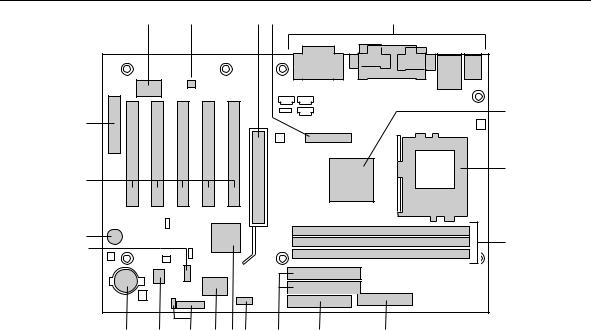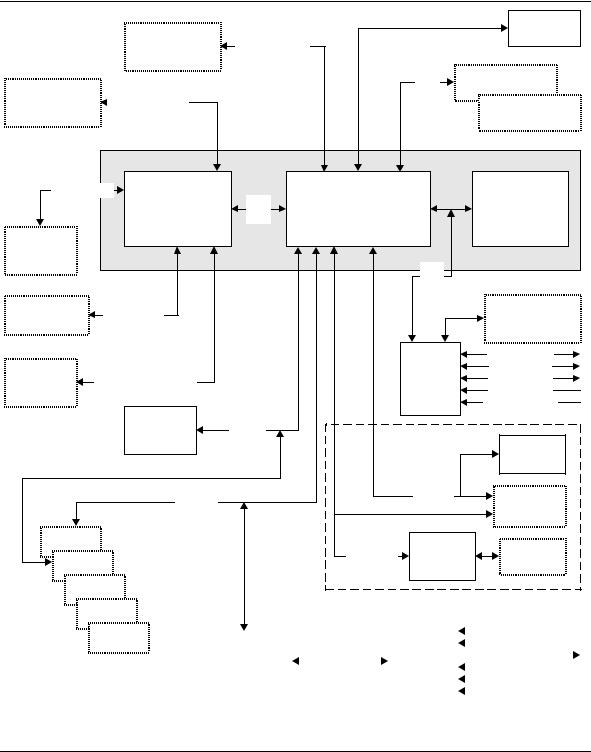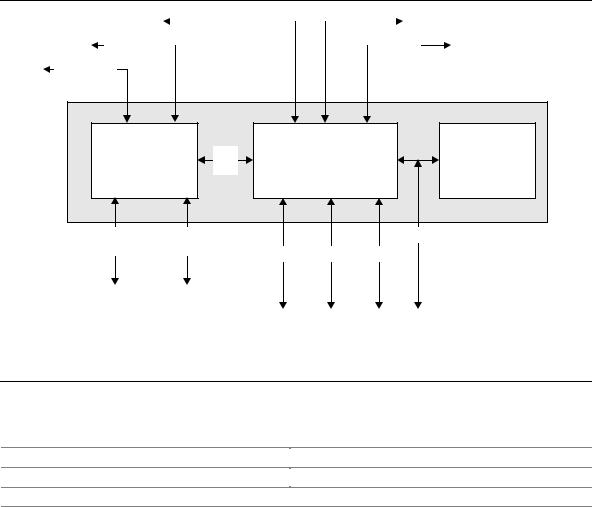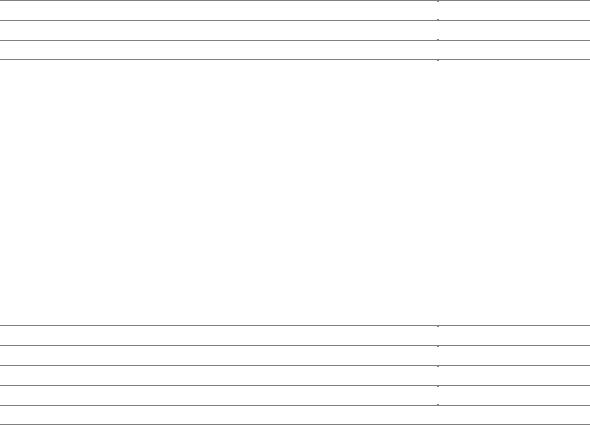INTEL D815EEA User Manual

Intel® Desktop Board D815EEA
Technical Product Specification
May 2000
Order Number A16964 –001
The Intel®Desktop Board D815EEA may contain design defects or errors known as errata that may cause the product to deviate from published specifications. Current characterized errata are documented in the Intel Desktop Board D815EEA Specification Update.

Revision History
Revision |
Revision History |
Date |
-P1 |
First review draft of the Intel Desktop Board D815EEA Technical Product |
March 2000 |
|
Specification |
|
-P2 |
Second review draft of the Intel Desktop Board D815EEA Technical |
April 2000 |
|
Product Specification |
|
-P3 |
Third review draft of the Intel Desktop Board D815EEA Technical Product |
June 2000 |
|
Specification |
|
-001 |
First release of the Intel Desktop Board D815EEA Technical Product |
June 2000 |
|
Specification |
|
This product specification applies to only standard D815EEA boards with BIOS identifier EA81510A.86A.
Changes to this specification will be published in the Intel Desktop Board D815EEA Specification Update before being incorporated into a revision of this document.
Information in this document is provided in connection with Intel® products. No license, express or implied, by estoppel or otherwise, to any intellectual property rights is granted by this document. Except as provided in Intel’s Terms and Conditions of Sale for such products, Intel assumes no liability whatsoever, and Intel disclaims any express or implied warranty, relating to sale and/or use of Intel products including liability or warranties relating to fitness for a particular purpose, merchantability, or infringement of any patent, copyright or other intellectual property right. Intel products are not intended for use in medical, life saving, or life sustaining applications.
Intel may make changes to specifications and product descriptions at any time, without notice.
The Intel® Desktop Board D815EEA may contain design defects or errors known as errata that may cause the product to deviate from published specifications. Current characterized errata are available on request.
Contact your local Intel sales office or your distributor to obtain the latest specifications before placing your product order.
Copies of documents which have an ordering number and are referenced in this document, or other Intel literature, may be obtained from:
Intel Corporation
P.O. Box 5937
Denver, CO 80217-9808
or call in North America 1-800-548-4725, Europe 44-0-1793-431-155, France 44-0-1793-421-777, Germany 44-0-1793-421-333, other Countries 708-296-9333.
† Third-party brands and names are the property of their respective owners.
Copyright © 2000, Intel Corporation. All rights reserved.

Preface
This Technical Product Specification (TPS) specifies the board layout, components, connectors, power and environmental requirements, and the BIOS for the Intel Desktop Board D815EEA. It describes the standard product and available manufacturing options.
Intended Audience
The TPS is intended to provide detailed, technical information about the D815EEA board and its components to the vendors, system integrators, and other engineers and technicians who need this level of information. It is specifically not intended for general audiences.
What This Document Contains
Chapter Description
1A description of the hardware used on the D815EEA board
2A map of the resources of the board
3The features supported by the BIOS Setup program
4The contents of the BIOS Setup program’s menus and submenus
5A description of the BIOS error messages, beep codes, POST codes, and diagnostic LEDs
Typographical Conventions
This section contains information about the conventions used in this specification. Not all of these symbols and abbreviations appear in all specifications of this type.
Notes, Cautions, and Warnings
NOTE
Notes call attention to important information.
CAUTION
Cautions are included to help you avoid damaging hardware or losing data.
WARNING
Warnings indicate conditions, which if not observed, can cause personal injury.
iii

Intel®Desktop Board D815EEA Technical Product Specification
Other Common Notation
#Used after a signal name to identify an active-low signal (such as USBP0#)
(NxnX) |
When used in the description of a component, N indicates component type, xn are the relative |
|
|
coordinates of its location on the D815EEA board, and X is the instance of the particular part |
|
|
at that general location. For example, J5J1 is a connector, located at 5J. It is the first |
|
|
connector in the 5J area. |
|
GB |
Gigabyte (1,073,741,824 bytes) |
|
KB |
Kilobyte |
(1024 bytes) |
Kbit |
Kilobit |
(1024 bits) |
kbits/sec |
1000 bits per second |
|
MB |
Megabyte (1,048,576 bytes) |
|
MB/sec |
Megabytes per second |
|
Mbit |
Megabit |
(1,048,576 bits) |
Mbit/sec |
Megabits per second |
|
|
|
|
xxh |
An address or data value ending with a lowercase h indicates a hexadecimal value. |
|
x.x V |
Volts. Voltages are DC unless otherwise specified. |
|
†This symbol is used to indicate third-party brands and names that are the property of their respective owners.
iv

Contents
1 Product Description
1.1 |
Overview ................................................................................................................... |
12 |
|
|
1.1.1 |
Feature Summary ....................................................................................... |
12 |
|
1.1.2 |
Manufacturing Options ................................................................................ |
13 |
|
1.1.3 |
D815EEA Board Layout .............................................................................. |
14 |
|
1.1.4 |
Block Diagram............................................................................................. |
15 |
1.2 |
Online Support........................................................................................................... |
16 |
|
1.3 |
Design Specifications ................................................................................................ |
16 |
|
1.4 |
Processor .................................................................................................................. |
19 |
|
1.5 |
System Memory......................................................................................................... |
20 |
|
1.6 |
Intel® 815E Chipset ................................................................................................... |
22 |
|
|
1.6.1 |
Intel® 82815E Graphics and Memory Controller Hub (GMCH) .................... |
23 |
|
1.6.2 |
Intel® 82801BA I/O Controller Hub (ICH2)................................................... |
23 |
|
1.6.3 |
Intel® 82802AB 4 Mbit Firmware Hub (FWH) .............................................. |
25 |
1.7 |
I/O Controller ............................................................................................................. |
26 |
|
|
1.7.1 |
Serial Ports.................................................................................................. |
26 |
|
1.7.2 |
Infrared Support .......................................................................................... |
26 |
|
1.7.3 |
Parallel Port................................................................................................. |
27 |
|
1.7.4 |
Diskette Drive Controller.............................................................................. |
27 |
|
1.7.5 |
Keyboard and Mouse Interface ................................................................... |
27 |
1.8 |
Graphics Subsystem ................................................................................................. |
28 |
|
|
1.8.1 |
Integrated Graphics Controller .................................................................... |
28 |
|
1.8.2 |
Digital Video Output (DVO) Connector ........................................................ |
30 |
|
1.8.3 |
AGP Universal Connector ........................................................................... |
31 |
1.9 |
Audio Subsystem (Optional) ...................................................................................... |
32 |
|
|
1.9.1 |
Basic Audio Subsystem............................................................................... |
32 |
|
1.9.2 |
Enhanced PCI Audio Subsystem................................................................. |
33 |
|
1.9.3 |
Audio Connectors........................................................................................ |
34 |
1.10 LAN Subsystem......................................................................................................... |
35 |
||
|
1.10.1 Intel® 82562ET Platform LAN Connect Device (Optional) ........................... |
36 |
|
|
1.10.2 RJ-45 LAN Connector LEDs........................................................................ |
36 |
|
|
1.10.3 |
LAN Subsystem Software............................................................................ |
36 |
1.11 CNR (Optional) .......................................................................................................... |
36 |
||
1.12 Hardware Management Subsystem (Optional) .......................................................... |
37 |
||
|
1.12.1 |
Hardware Monitor Component .................................................................... |
38 |
|
1.12.2 |
Chassis Intrusion Detect Connector ............................................................ |
38 |
|
1.12.3 |
Fan Control and Monitoring ......................................................................... |
38 |
1.13 Power Management .................................................................................................. |
39 |
||
|
1.13.1 |
Software Support ........................................................................................ |
39 |
|
1.13.2 |
Hardware Support ....................................................................................... |
42 |
v
Intel®Desktop Board D815EEA Technical Product Specification
2 Technical Reference
2.1 |
Introduction................................................................................................................ |
47 |
|
2.2 |
Memory Map ............................................................................................................. |
47 |
|
2.3 |
I/O Map |
..................................................................................................................... |
48 |
2.4 |
DMA Channels .......................................................................................................... |
50 |
|
2.5 |
PCI Configuration ...................................................................................Space Map |
50 |
|
2.6 |
Interrupts ................................................................................................................... |
51 |
|
2.7 |
PCI Interrupt .........................................................................................Routing Map |
51 |
|
2.8 |
Connectors ................................................................................................................ |
53 |
|
|
2.8.1 ............................................................................... |
Back Panel Connectors |
54 |
|
2.8.2 ............................................................................... |
Internal I/O Connectors |
58 |
|
2.8.3 .............................................................................. |
External I/O Connectors |
69 |
2.9 |
Jumper .............................................................................................................Block |
73 |
|
2.10 Mechanical ........................................................................................Considerations |
75 |
||
|
2.10.1 ................................................................................................. |
Form Factor |
75 |
|
2.10.2 .................................................................................................... |
I/O Shield |
76 |
2.11 |
Electrical ...........................................................................................Considerations |
77 |
|
|
2.11.1 .................................................................................... |
Power Consumption |
77 |
|
2.11.2 ....................................................................... |
Add - in Board Considerations |
78 |
|
2.11.3 ................................................................... |
Standby Current Requirements |
78 |
|
2.11.4 ............................................................... |
Fan Connector Current Capability |
79 |
|
2.11.5 ...................................................................... |
Power Supply Considerations |
80 |
2.12 Thermal .............................................................................................Considerations |
80 |
||
2.13 |
Reliability ................................................................................................................... |
82 |
|
2.14 Environmental............................................................................................................ |
83 |
||
2.15 Regulatory .............................................................................................Compliance |
84 |
||
|
2.15.1 ...................................................................................... |
Safety Regulations |
84 |
|
2.15.2 ........................................................................................ |
EMC Regulations |
84 |
|
2.15.3 .................................................................................. |
Certification Markings |
85 |
3 Overview of BIOS Features
3.1 |
Introduction................................................................................................................ |
87 |
|
3.2 |
BIOS Flash Memory Organization ............................................................................. |
88 |
|
3.3 |
Resource Configuration ............................................................................................. |
88 |
|
|
3.3.1 |
PCI Autoconfiguration ................................................................................. |
88 |
|
3.3.2 |
PCI IDE Support.......................................................................................... |
88 |
3.4 |
System Management BIOS (SMBIOS) ...................................................................... |
89 |
|
3.5 |
USB Legacy Support ................................................................................................. |
90 |
|
3.6 |
BIOS Updates............................................................................................................ |
90 |
|
|
3.6.1 |
Language Support....................................................................................... |
91 |
|
3.6.2 |
Custom Splash Screen................................................................................ |
91 |
3.7 |
Recovering BIOS Data .............................................................................................. |
91 |
|
3.8 |
Boot Options.............................................................................................................. |
92 |
|
|
3.8.1 |
CD-ROM and Network Boot ........................................................................ |
92 |
|
3.8.2 |
Booting Without Attached Devices .............................................................. |
92 |
vi
Contents
3.9 Fast Booting Systems with Intel® Rapid BIOS Boot ................................................... |
92 |
|
3.9.1 |
Peripheral Selection and Configuration ....................................................... |
93 |
3.9.2 |
Intel Rapid BIOS Boot ................................................................................. |
93 |
3.9.3 |
Operating System ....................................................................................... |
94 |
3.10 BIOS Security Features ............................................................................................. |
94 |
|
4 BIOS Setup Program
4.1 |
Introduction................................................................................................................ |
97 |
|
4.2 |
Maintenance Menu .................................................................................................... |
98 |
|
|
4.2.1 |
Extended Configuration Submenu............................................................... |
99 |
4.3 |
Main Menu............................................................................................................... |
100 |
|
4.4 |
Advanced Menu....................................................................................................... |
101 |
|
|
4.4.1 |
PCI Configuration Submenu...................................................................... |
102 |
|
4.4.2 |
Boot Configuration Submenu .................................................................... |
103 |
|
4.4.3 |
Peripheral Configuration Submenu............................................................ |
104 |
|
4.4.4 |
IDE Configuration Submenu...................................................................... |
106 |
|
4.4.5 |
Diskette Configuration Submenu ............................................................... |
109 |
|
4.4.6 |
Event Log Configuration Submenu............................................................ |
110 |
|
4.4.7 |
Video Configuration Submenu................................................................... |
111 |
4.5 |
Security Menu.......................................................................................................... |
112 |
|
4.6 |
Power Menu ............................................................................................................ |
113 |
|
4.7 |
Boot Menu ............................................................................................................... |
114 |
|
|
4.7.1 |
IDE Drive Configuration Submenu............................................................. |
115 |
4.8 |
Exit Menu ................................................................................................................ |
116 |
|
5 Error Messages and Beep Codes
5.1 |
BIOS Error Messages.............................................................................................. |
116 |
5.2 |
Port 80h POST Codes ............................................................................................. |
119 |
5.3 |
Bus Initialization Checkpoints .................................................................................. |
123 |
5.4 |
Speaker ................................................................................................................... |
124 |
5.5 |
BIOS Beep Codes ................................................................................................... |
124 |
5.6 |
Diagnostic LEDs ...................................................................................................... |
125 |
Figures
1. |
D815EEA Board Components ................................................................................... |
14 |
2. |
Block Diagram ........................................................................................................... |
15 |
3. |
Intel 815E Chipset Block Diagram ............................................................................. |
22 |
4. |
Block Diagram of Basic Audio Subsystem ................................................................. |
33 |
5. |
Block Diagram of Enhanced PCI Audio Subsystem ................................................... |
33 |
6. |
ICH2 and CNR Signal Interface ................................................................................. |
37 |
7. |
Using the Wake on LAN Technology Connector........................................................ |
44 |
8. |
Location of Standby Power Indicator LED ................................................................. |
45 |
9. |
Back Panel Connectors ............................................................................................. |
54 |
10. |
Audio, Video, Hardware Control, and Fan Connectors .............................................. |
59 |
11. |
Add-in Board and Peripheral Interface Connectors.................................................... |
63 |
12. |
External I/O Connectors ............................................................................................ |
69 |
13. |
Location of the Jumper Block .................................................................................... |
73 |
vii
Intel®Desktop Board D815EEA Technical Product Specification
14. |
D815EEA Board Dimensions..................................................................................... |
75 |
15. |
I/O Shield Dimensions ............................................................................................... |
76 |
16. |
Localized High Temperature Zones ........................................................................... |
81 |
17. |
Diagnostic LEDs ...................................................................................................... |
125 |
Tables |
|
|
1. |
Feature Summary...................................................................................................... |
12 |
2. |
Manufacturing Options............................................................................................... |
13 |
3. |
Specifications ............................................................................................................ |
16 |
4. |
Supported Processors ............................................................................................... |
19 |
5. |
Supported Memory Configurations ............................................................................ |
21 |
6. |
Supported Graphics Refresh Frequencies................................................................. |
29 |
7. |
LAN Connector LED States ....................................................................................... |
36 |
8. Effects of Pressing the Power Switch ........................................................................ |
40 |
|
9. |
Power States and Targeted System Power ............................................................... |
41 |
10. |
Wake Up Devices and Events ................................................................................... |
42 |
11. |
Fan Connector Descriptions ...................................................................................... |
43 |
12. |
System Memory Map................................................................................................. |
47 |
13. |
I/O Map ..................................................................................................................... |
48 |
14. |
DMA Channels .......................................................................................................... |
50 |
15. |
PCI Configuration Space Map ................................................................................... |
50 |
16. |
Interrupts ................................................................................................................... |
51 |
17. |
PCI Interrupt Routing Map ......................................................................................... |
52 |
18. |
PS/2 Mouse/Keyboard Connectors............................................................................ |
55 |
19. |
LAN Connector .......................................................................................................... |
55 |
20. |
USB Connectors........................................................................................................ |
55 |
21. |
VGA Port Connector.................................................................................................. |
56 |
22. |
Parallel Port Connector.............................................................................................. |
56 |
23. |
Serial Port A Connector ............................................................................................. |
56 |
24. |
MIDI/Game Port Connector ....................................................................................... |
57 |
25. |
Audio Line Out Connector ......................................................................................... |
57 |
26. |
Audio Line In Connector ............................................................................................ |
57 |
27. |
Mic In Connector ....................................................................................................... |
57 |
28. |
Chassis Fan Connector (J3F1) .................................................................................. |
60 |
29. |
CD-ROM Legacy Style Connector (J2F2).................................................................. |
60 |
30. |
ATAPI CD-ROM Connector (J2F1)............................................................................ |
60 |
31. |
Auxiliary Line In Connector (J2G1) ............................................................................ |
60 |
32. |
Telephony Connector (J2G2)..................................................................................... |
60 |
33. |
Digital Video Out Connector (J3H1)........................................................................... |
61 |
34. |
Processor Fan Connector (J3M1).............................................................................. |
61 |
35. |
Power Connector (J8K1) ........................................................................................... |
61 |
36. |
Wake on LAN Technology Connector (J6B1) ............................................................ |
62 |
37. |
Chassis Intrusion Connector (J7B1) .......................................................................... |
62 |
38. |
Chassis Fan Connector (J8B1).................................................................................. |
62 |
39. |
CNR Connector (J3A1).............................................................................................. |
64 |
40. |
PCI Bus Connectors (J4A1, J4B1, J4C1, J4D1, J4E1) .............................................. |
65 |
viii
Contents
41. |
AGP Universal Connector (J5E1) .............................................................................. |
66 |
42. |
Diskette Drive Connector (J8G3) ............................................................................... |
67 |
43. |
PCI IDE Connectors (J8G2, Primary and J6G1, Secondary) ..................................... |
68 |
44. |
Front Panel USB Connector (J8C1)........................................................................... |
70 |
45. |
Serial Port B Connector (J8E1).................................................................................. |
70 |
46. |
SCSI LED Connector (J7A1) ..................................................................................... |
70 |
47. |
Auxiliary Front Panel Power LED Connector (J8C2).................................................. |
70 |
48. |
Front Panel Connector (J8C3) ................................................................................... |
71 |
49. |
States for a Single-Colored Power LED..................................................................... |
72 |
50. |
States for a Dual-Colored Power LED ....................................................................... |
72 |
51. |
BIOS Setup Configuration Jumper Settings (J7B1) ................................................... |
74 |
52. |
Power Usage For Board with Basic Audio and Onboard LAN.................................... |
77 |
53.Power Usage For Board with Enhanced PCI Audio Subsystem and
|
no Onboard LAN subsystem...................................................................................... |
78 |
54. |
Standby Current Requirements ................................................................................. |
79 |
55. |
Thermal Considerations for Components .................................................................. |
82 |
56. |
D815EEA Board Environmental Specifications .......................................................... |
83 |
57. |
Safety Regulations .................................................................................................... |
84 |
58. |
EMC Regulations....................................................................................................... |
84 |
59. |
Supervisor and User Password Functions ................................................................. |
95 |
60. |
BIOS Setup Program Menu Bar................................................................................. |
97 |
61. |
BIOS Setup Program Function Keys ......................................................................... |
98 |
62. |
Maintenance Menu .................................................................................................... |
98 |
63. |
Extended Configuration Submenu ............................................................................. |
99 |
64. |
Main Menu............................................................................................................... |
100 |
65. |
Advanced Menu....................................................................................................... |
101 |
66. |
PCI Configuration Submenu .................................................................................... |
102 |
67. |
Boot Configuration Submenu................................................................................... |
103 |
68. |
Peripheral Configuration Submenu .......................................................................... |
104 |
69. |
IDE Configuration Submenu .................................................................................... |
106 |
70. |
Primary/Secondary IDE Master/Slave Submenus.................................................... |
107 |
71. |
Diskette Configuration Submenu ............................................................................. |
109 |
72. |
Event Log Configuration Submenu .......................................................................... |
110 |
73. |
Video Configuration Submenu ................................................................................. |
111 |
74. |
Security Menu.......................................................................................................... |
112 |
75. |
Power Menu ............................................................................................................ |
113 |
76. |
Boot Menu ............................................................................................................... |
114 |
77. |
IDE Drive Configuration Submenu........................................................................... |
115 |
78. |
Exit Menu ................................................................................................................ |
116 |
79. |
BIOS Error Messages.............................................................................................. |
116 |
80. |
Uncompressed INIT Code Checkpoints................................................................... |
119 |
81. |
Boot Block Recovery Code Checkpoints ................................................................. |
119 |
82. |
Runtime Code Uncompressed in F000 Shadow RAM ............................................. |
120 |
83. |
Bus Initialization Checkpoints .................................................................................. |
123 |
84. |
Upper Nibble High Byte Functions ........................................................................... |
123 |
85. |
Lower Nibble High Byte Functions ........................................................................... |
124 |
86. |
Beep Codes............................................................................................................. |
125 |
87. |
Diagnostic LED Codes............................................................................................. |
126 |
ix
Intel®Desktop Board D815EEA Technical Product Specification
x

1 Product Description
What This Chapter Contains |
|
|
1.1 |
Overview ................................................................................................................... |
12 |
1.2 |
Online Support........................................................................................................... |
16 |
1.3 |
Design Specifications ................................................................................................ |
16 |
1.4 |
Processor .................................................................................................................. |
19 |
1.5 |
System Memory......................................................................................................... |
20 |
1.6 |
Intel® 815E Chipset ................................................................................................... |
22 |
1.7 |
I/O Controller ............................................................................................................. |
26 |
1.8 |
Graphics Subsystem ................................................................................................. |
28 |
1.9 |
Audio Subsystem (Optional) ...................................................................................... |
32 |
1.10 LAN Subsystem......................................................................................................... |
35 |
|
1.11 CNR (Optional) .......................................................................................................... |
36 |
|
1.12 Hardware Management Subsystem (Optional) .......................................................... |
37 |
|
1.13 Power Management .................................................................................................. |
39 |
|
11

Intel®Desktop Board D815EEA Technical Product Specification
1.1 Overview
1.1.1Feature Summary
Table 1 summarizes the D815EEA board’s major features.
Table 1. Feature Summary
Form Factor
Processor
Memory
Chipset
I/O Control
Video
Peripheral
Interfaces
Expansion
Capabilities
BIOS
Diagnostic LEDs
Instantly Available
PC
Wake on LAN†
Technology
Connector
ATX (12.0 inches by 8.2 inches)
Support for either an Intel®Pentium® III processor in a Flip Chip Pin Grid Array (FC-PGA) package or an Intel®Celeron™ processor in an FCPGA package or a PPGA package
∙Three 168-pin SDRAM Dual Inline Memory Module (DIMM) sockets
∙Support for up to 512 MB system memory
∙Singleor double-sided DIMMs supported
Intel®815E Chipset, consisting of:
∙Intel®82815E Graphics and Memory Controller Hub (GMCH)
∙Intel®82801BA I/O Controller Hub (ICH2)
∙Intel®82802AB 4 Mbit Firmware Hub (FWH)
SMSC LPC47M102 LPC bus I/O controller
∙Intel®82815E integrated graphics support
∙AGP universal connector supporting 1X, 2X, and 4X AGP cards or a Graphics Performance Accelerator (GPA)
∙Digital video output (DVO) connector
∙Four Universal Serial Bus (USB) ports
∙Two serial ports
∙One parallel port
∙Two IDE interfaces with Ultra DMA, ATA-66/100 support
∙One diskette drive interface
∙MIDI/game port
∙PS/2† keyboard and mouse ports
∙Five PCI bus add-in card connectors (SMBus routed to PCI bus connector 2)
∙One AGP universal connector
∙Intel/AMI BIOS (resident in the Intel 82802AB 4 Mbit FWH)
∙Support for Advanced Power Management (APM), Advanced Configuration and Power Interface (ACPI), Plug and Play, and SMBIOS
Four dual-color LEDs on back panel
∙Support for PCI Local Bus Specification Revision 2.2
∙Suspend to RAM support
∙Wake on PS/2 keyboard and USB ports
Support for system wake up using an add-in network interface card with remote wake up capability
For information about |
Refer to |
The board’s compliance level with APM, ACPI, Plug and Play, and SMBIOS. |
Section 1.3, page 16 |
|
|
12

Product Description
1.1.2Manufacturing Options
Table 2 describes the D815EEA board’s manufacturing options.
Table 2. Manufacturing Options
Audio
LAN
Hardware Monitor
Subsystem
Communication
and Networking
Riser (CNR)
Two separate Audio Codec ’97 (AC ’97) compatible audio subsystem options:
∙A basic audio subsystem that includes the ICH2 component and an Analog Devices AD1885 analog codec, or
∙An enhanced audio subsystem that includes a Creative Labs ES1373 AC ’97 digital controller and a Crystal Semiconductor CS4297 stereo audio codec.
Intel®82562ET 10/100 Mbit/sec Platform LAN Connect (PLC) device
∙Voltage sense to detect out of range values
∙Chassis intrusion detect connector
∙Two fan sense inputs used to monitor fan activity
One CNR connector (slot shared with PCI bus connector 5)
13

Intel®Desktop Board D815EEA Technical Product Specification
1.1.3D815EEA Board Layout
Figure 1 shows the location of the major components on the D815EEA board.
|
A |
B |
|
C D |
|
E |
U |
|
|
|
|
|
F |
|
|
|
|
|
|
|
T |
|
|
|
|
|
G |
|
|
|
|
|
|
|
S |
|
|
|
|
|
H |
R |
|
|
|
|
|
|
|
|
|
|
|
|
|
Q |
P |
O |
N M L |
K |
J |
I |
|
|
|
|
|
|
OM10041 |
A |
Creative Labs ES1373 Digital Controller |
K |
IDE connectors |
|
(optional) |
L |
Serial port B connector |
B |
AD1885 audio codec (optional) |
M |
Intel 82801BA I/O Controller Hub (ICH2) |
C |
AGP universal connector |
N SMSC LPC47M102 I/O Controller |
|
D |
DVO connector |
O |
Front panel connectors |
E |
Back panel connectors |
P Intel 82802AB 4 Mbit Firmware Hub (FWH) |
|
F |
Intel 82815E Graphics and Memory Controller |
Q |
Battery |
|
Hub (GMCH) |
R |
Front panel USB connector |
G |
Processor socket |
S |
Speaker |
H |
DIMM sockets |
T PCI bus add-in card connectors |
|
I |
Power connector |
U |
Communication and Networking Riser (CNR) |
J |
Diskette drive connector |
|
connector (optional) |
|
|
|
|
Figure 1. D815EEA Board Components
14

Product Description
1.1.4Block Diagram
Figure 2 is a block diagram of the major functional areas of the D815EEA board.
Diagnostic
Primary/
LEDs
Secondary IDE
ATA-33/66/100
USB USB Ports 0 and 1
Processor Socket |
|
System Bus |
|
USB Ports 2 and 3
|
|
|
815E Chipset |
|
|
|
SDRAM Bus |
82815E |
|
82801BA |
|
82802AB |
|
|
|
Graphics and |
AHA |
|
||
|
|
I/O Controller Hub |
|
Firmware Hub |
||
|
|
Memory Controller |
Bus |
|
||
|
|
(ICH2) |
|
(FWH) |
||
|
|
Hub (GMCH) |
|
|
||
DIMM |
|
|
|
|
|
|
|
|
|
|
|
|
|
Banks |
|
|
|
|
|
|
(3) |
|
|
|
|
LPC |
|
|
|
|
|
|
|
|
|
|
|
|
|
Bus |
|
DVO |
Digital video |
|
|
|
Diskette Drive |
|
Connector |
|
output |
|
|
|
|
|
|
|
|
Connector |
||
|
|
|
|
|
|
|
|
|
|
|
|
|
Serial Port A |
AGP |
AGP / Display Cache |
|
|
LPC I/O |
Serial Port B |
|
Universal |
|
|
Controller |
Parallel Port |
||
|
Interface |
|
|
PS/2 Mouse |
||
Connector |
|
|
|
|
||
|
|
|
|
|
PS/2 Keyboard |
|
|
|
|
|
|
|
|
|
|
Hardware |
|
|
|
|
|
|
Monitor |
SMBus |
|
Optional |
|
|
|
(Optional) |
|
|
Analog |
|
|
|
|
|
|
||
|
|
|
|
|
|
|
|
|
|
|
|
|
Codec |
|
|
PCI Bus |
|
|
AC Link |
CNR |
|
|
|
|
|
||
|
|
|
|
|
|
Connector |
PCI Slot 1 |
|
|
|
CSMA/CD |
Physical |
LAN |
|
|
|
|
Unit |
Layer |
|
PCI Slot 2 |
|
|
Connector |
|||
|
|
Interface |
Interface |
|||
|
|
|
|
|
||
PCI Slot 3
PCI Slot 4 |
|
|
|
|
|
|
|
|
|
|
|
|
|
|
|
|
|
|
|
|
|
|
|
|
|
|
|
|
|
|
|
|
|
|
|
|
|
|
|
|
|
|
|
|
|
|
|
|
|
|
|
|
|
|
|
|
|
|
|
|
|
|
|
|
|
|
|
|
|
|
|
|
|
|
|
|
|
|
|
|
|
|
|
|
|
|
|
|
|
|
|
|
|
|
|
|
|
|
|
|
|
|
|
|
|
|
|
|
|
|
|
|
|
|
|
|
|
|
|
|
|
|
|
|
|
|
|
|
|
|
|
|
|
|
|
|
Optional |
|
|
|
|
|
|
|
|
|
|
|
|
|
|
|
|
|
|
|
|
|
|
|
|
|
|
|
|
|
|
|
|
|
|
|
|
|
|
|
|
|
|
|
|
|
|
|
|
|
|
|
|
|
|
|
|
|
|
|
|
|
|
|
|
|
|
|
|
|
|
|
|
|
|
|
|
|
|
|
|
|
|
|
|
|
|
|
|
|
|
|
|
|
|
|
|
|
|
|
|
||||||||||||||||||||||||||||||
|
PCI Slot 5 |
|
|
|
|
|
|
|
|
|
|
|
|
|
|
|
|
|
|
|
|
|
|
|
|
|
|
|
|
|
|
|
|
|
|
|
|
|
|
|
|
|
|
|
|
|
|
|
|
|
|
|
|
|
|
|
|
|
|
|
|
|
|
|
|
|
|
|
|
|
|
|
|
|
|
|
|
|
|
|
|
|
|
|
|
|
|
|
|
|
|
|
|
|
|
|
|
|
|
|
|
|
CD-ROM |
|
|
||||||||||||||||||||||||||||
|
|
|
|
|
|
|
|
|
|
|
|
|
|
Audio Digital |
|
|
|
|
|
|
|
|
|
|
|
|
|
|
|
|
|
|
|
|
|
|
|
|
|
|
|
|
|
|
|
|
|
|
|
|
|
|
|
|
|
|
|
AC ’97 |
|
|
|
|
|
|
|
|
|
|
|
|
|
|
|
|
Line In |
|
|
||||||||||||||||||||||||||||||||||||||||||||||||||||||||
|
|
|
|
|
|
|
|
|
|
|
|
|
|
|
|
|
|
|
|
|
|
|
|
|
|
|
|
|
|
|
|
|
|
|
|
|
|
|
|
|
|
|
|
|
|
|
|
|
|
|
|
|
|
|
|
|
|
|
|
|
|
|
|
|
|
|
|
|
|
|
|
|
|
|
|||||||||||||||||||||||||||||||||||||||||||||||||||||||||||
|
|
|
|
|
|
|
|
|
|
|
|
|
|
|
|
|
|
|
|
|
|
|
|
|
|
|
|
|
|
|
|
|
|
|
|
|
|
|
|
|
|
|
|
|
|
|
|
|
|
|
|
|
|
|
|
|
|
|
|
|
|
|
|
|
|
|
|
|
|
|
|
|
Line Out |
|
|
|
|
|
|
|
|
|
|
|
|
|
|
||||||||||||||||||||||||||||||||||||||||||||||
|
|
|
|
|
|
|
|
|
|
|
|
|
|
|
|
|
|
|
|
|
|
|
|
|
|
|
|
|
|
|
|
|
|
|
|
|
|
|
|
|
|
|
|
|
|
|
|
|
|
|
|
|
|
|
|
|
|
Audio |
|
|
|
|
|
|
|
|
|
|
|
|
|
|
|
|
|
|
|
|
|
|
|
|
|
|
|
|
|
|
|||||||||||||||||||||||||||||||||||||||||||||
|
|
|
|
|
|
|
|
|
|
|
|
|
|
|
|
|
|
|
|
|
|
|
|
|
|
|
|
|
AC Link |
|
|
|
|
|
|
|
|
|
|
|
|
|
|
|
|
|
|
|
|
|
|
|
|
|
|
|
|
|
|
|
|
|
|
|
|
||||||||||||||||||||||||||||||||||||||||||||||||||||||||||||||||||||
|
|
|
|
|
|
|
|
|
|
|
|
|
|
|
|
|
Controller |
|
|
|
|
|
|
|
|
|
|
|
|
|
|
|
|
|
|
|
|
|
|
|
|
|
|
|
|
|
|
|
|
|
|
|
|
|
|
|
|
|
|
|
|
|
|
|
Mic In |
|
|
|
|
|
|
|
|
|
|
|
|
|
|
|
|
|
|
||||||||||||||||||||||||||||||||||||||||||||||||||
|
|
|
|
|
|
|
|
|
|
|
|
|
|
|
|
|
|
|
|
|
|
|
|
|
|
|
|
|
|
|
|
|
|
|
|
|
|
|
|
|
|
|
|
|
|
|
|
|
|
|
|
|
|
|
|
|
|
|
|
Codec |
|
|
|
|
|
|
|
|
|
|
|
|
|
|
|
|
|
|
|
|
|
|
|
|
|
|
|
|
|
|
|
|
|
|
|||||||||||||||||||||||||||||||||||||||
|
|
|
|
|
|
|
|
|
|
|
|
|
|
|
|
|
|
|
|
|
|
|
|
|
|
|
|
|
|
|
|
|
|
|
|
|
|
|
|
|
|
|
|
|
|
|
|
|
|
|
|
|
|
|
|
|
|
|
|
|
|
|
|
|
|
|
|
|
|
|
|
|
|
|
|
|
|
|
|
|
|
|
|
|
|
Auxiliary Line In |
|
|
|
|
|
|
|
|
|||||||||||||||||||||||||||||||||||||||
|
|
|
|
|
|
|
|
|
|
|
|
|
|
|
|
|
|
|
|
|
|
|
|
|
|
|
|
|
|
|
|
|
|
|
|
|
|
|
|
|
|
|
|
|
|
|
|
|
|
|
|
|
|
|
|
|
|
|
|
|
|
|
|
|
|
|
|
|
|
|
|
|
|
|
|
|
|
|
|
|
|
|
|
|
|
|
|
|
|
|
|
|
|
|
|
|
|
|
|
||||||||||||||||||||||||||||||||||
|
|
|
|
|
|
|
|
|
|
|
|
|
|
|
|
|
|
|
|
|
|
|
|
|
|
|
|
|
|
|
|
|
|
|
|
|
|
|
|
|
|
|
|
|
|
|
|
|
|
|
|
|
|
|
|
|
|
|
|
|
|
|
|
|
|
|
|
|
|
|
|
|
|
|
|
|
|
|
|
|
|
|
|
|
|
|
|
|
|
|
|
|
|
|
|
|
|
|
|
|
|
Telephony |
|
|
|
||||||||||||||||||||||||||||
|
|
|
|
|
|
|
|
|
|
|
|
|
|
|
|
|
|
|
|
|
|
|
|
|
|
|
|
|
|
|
|
|
|
|
|
|
|
|
|
|
|
|
|
|
|
|
|
|
|
|
|
|
|
|
|
|
|
|
|
|
|
|
|
|
|
|
|
|
|
|
|
|
|
|
|
|
|
|
|
|
|
|
|
|
|
|
|
|
|
|
|
|
|
|
|
|
|
|
|
|
|
|
|
|
|||||||||||||||||||||||||||||
|
|
|
|
|
|
|
|
|
|
|
|
|
|
|
|
|
|
|
|
|
|
|
|
|
|
|
|
|
|
|
|
|
|
|
|
|
|
|
|
|
|
|
|
|
|
|
|
|
|
|
|
|
|
|
|
|
|
|
|
|
|
|
|
|
|
|
|
|
|
|
|
|
|
|
|
|
|
|
|
|
|
|
|
|
|
|
|
|
|
|
|
|
|
|
|
|
|
|
|
|
|
|
|
|
|
|
|
|
|
|
|
|
|
|
|
|
|
|
|
|
|
|
|
|
|
|
|
|
|
|
|
|
|
|
|
|
|
|
|
|
|
|
|
|
|
|
|
|
|
|
|
|
|
|
|
|
|
|
|
|
|
|
|
|
|
|
|
|
|
|
|
|
|
|
|
|
|
|
|
|
|
|
|
|
|
|
|
|
|
|
|
|
|
|
|
|
|
|
|
|
|
|
|
|
|
|
|
|
|
|
|
|
|
|
|
|
|
|
|
|
|
|
|
|
|
|
|
|
|
|
|
|
|
|
|
|
|
|
|
|
|
|
|
|
|
|
|
|
|
|
|
|
|
|
|
|
|
|
|
|
|
|
|
|
|
|
|
|
|
|
|
|
|
|
|
|
|
|
|
|
|
|
|
|
|
|
|
|
|
|
|
|
|
|
|
|
|
|
|
|
|
|
|
|
|
|
|
|
|
|
|
|
|
|
|
|
|
|
|
|
|
|
|
|
|
|
|
|
|
|
|
|
|
|
|
|
|
|
|
|
|
|
|
|
|
|
|
|
|
|
|
|
|
|
|
|
|
|
|
|
|
|
|
|
|
|
|
|
|
|
|
|
|
|
|
|
|
|
|
|
|
|
|
|
|
|
|
|
|
|
|
|
|
|
|
|
|
|
|
|
|
|
|
|
|
|
|
|
|
|
|
|
|
|
|
|
|
|
|
|
|
|
|
|
|
|
|
|
|
|
|
|
|
|
|
|
|
|
|
|
|
|
|
|
|
|
|
|
|
|
|
|
|
|
|
|
|
|
|
|
|
|
|
|
|
|
|
|
|
|
|
|
|
|
|
|
|
|
|
|
|
|
|
|
|
|
|
|
|
|
|
|
|
|
|
|
|
|
|
|
|
|
|
|
|
|
|
|
|
|
|
|
|
|
|
|
|
|
|
|
|
|
OM10090 |
||||||||||||
Figure 2. Block Diagram
15

Intel®Desktop Board D815EEA Technical Product Specification
1.2 Online Support
Find information about the Intel®D815EEA board under “Product Info” or “Customer Support” at these World Wide Web sites:
http://www.intel.com/design/motherbd
http://support.intel.com/support/motherboards/desktop
Find “Processor Data Sheets” or information about “Proper Date Access in Systems with Intel ® Motherboards” at these World Wide Web sites:
http://www.intel.com/design/litcentr
http://support.intel.com/support/year2000
Find information about the ICH addressing at this World Wide Web site:
http://developer.intel.com/design/chipsets/datashts/
1.3 Design Specifications
Table 3 lists the specifications applicable to the D815EEA board.
Table 3. |
Specifications |
|
|
|
|
|
|
|
|
Reference |
|
Specification |
Version, Revision Date, |
The information is |
Name |
|
Title |
and Ownership |
available from… |
AC ‘97 |
|
Audio Codec ‘97 |
Version 2.1, |
ftp://download.intel.com/ |
|
|
|
May 1998, |
pc-supp/platform/ac97 |
|
|
|
Intel Corporation. |
|
ACPI |
|
Advanced Configuration |
Version 1.0b, |
http://www.teleport.com/~acpi/ |
|
|
and Power Interface |
February 1, 1999, |
|
|
|
Specification |
Intel Corporation, |
|
|
|
|
Microsoft Corporation, |
|
|
|
|
and Toshiba Corporation. |
|
AGP |
|
Accelerated Graphics Port |
Version 2.0, |
the Accelerated Graphics |
|
|
Interface Specification |
May 4, 1998, |
Implementers Forum at: |
|
|
|
Intel Corporation. |
http://www.agpforum.org/ |
AIMM |
|
AGP Inline Memory Module |
Version 0.9, |
http://developer.intel.com/ |
(for Graphics |
|
March 2000, |
technology/memory/aimm/ |
|
|
Intel Corporation |
index.htm |
||
Performance |
|
|||
|
|
|
||
Accelerator |
|
|
|
Intel document order number |
cards) |
|
|
|
298177-003 |
AMI BIOS |
|
American Megatrends |
AMIBIOS 99, |
http://www.amibios.com, or |
|
|
BIOS Specification |
1999 |
http://www.ami.com/download/ |
|
|
|
American Megatrends, Inc. |
amibios99.pdf |
APM |
|
Advanced Power |
Version 1.2, |
http://www.microsoft.com/ |
|
|
Management BIOS |
February 1996, |
hwdev/busbios/amp_12.htm |
|
|
Interface Specification |
Intel Corporation, |
|
|
|
|
Microsoft Corporation. |
|
|
|
|
|
continued |
16

Product Description
Table 3. |
Specifications (continued) |
|
|
|
|
|
|
|
|
|
|
Specification |
Version, Revision Date and |
The information is |
Description |
|
Title |
Ownership |
available from… |
ATA-3 |
|
Information Technology - |
Version 6, |
ATA Anonymous FTP Site: |
|
|
AT Attachment-3 |
October 1995, |
ftp://www.dt.wdc.com/ata/ |
|
|
Interface, |
ASC X3T10 Technical |
ata-3/ |
|
|
X3T10/2008D |
Committee. |
|
ATAPI |
|
Information Technology |
Version 18, |
T13 Anonymous FTP Site: |
|
|
AT Attachment with |
August 19, 1998, |
ftp://fission.dt.wdc.com/ |
|
|
Packet Interface |
Contact: T13 Chair, |
x3t13/project/ |
|
|
Extensions |
Seagate Technology. |
d1153r18.pdf |
|
|
T13/1153D |
|
|
ATX |
|
ATX Specification |
Version 2.01, |
http://developer.intel.com/ |
|
|
|
February 1997, |
design/motherbd/atx.htm |
|
|
|
Intel Corporation. |
|
CNR |
|
Communication and |
Version 1.0, |
http://developer.intel.com/ |
|
|
Network Riser (CNR) |
February 7, 2000, |
technology/cnr/index.htm |
|
|
Specification |
Intel Corporation |
|
EPP |
|
Enhanced Parallel Port |
Version 1.7, |
http://standards.ieee.org/ |
|
|
IEEE std 1284.1-1997 |
1997, |
reading/ieee/std_public/ |
|
|
|
Institute of Electrical and |
description/busarch/ |
|
|
|
Electronic Engineers. |
1284.1-1997_desc.html |
El Torito |
|
Bootable CD-ROM |
Version 1.0, |
the Phoenix Web site at: |
|
|
format specification |
January 25, 1995, |
http://www.ptltd.com/techs/ |
|
|
|
Phoenix Technologies Ltd., and |
specs.html |
|
|
|
IBM Corporation. |
|
GPA (see |
|
|
|
|
AIMM) |
|
|
|
|
IrDA† |
|
Serial Infrared Physical |
Version 1.1, |
Phone: (510) 943-6546 |
|
|
Layer Link specification |
October 17, 1995, |
Fax: (510) 943-5600 |
|
|
|
Infrared Data Association. |
E-mail: irda@netcom.com |
LPC |
|
Low Pin Count Interface |
Version 1.0, |
http://www.intel.com/ |
|
|
Specification |
September 29, 1997, |
design/chipsets/industry/ |
|
|
|
Intel Corporation. |
lpc.htm |
PCI |
|
PCI Local Bus |
Version 2.2, |
http://www.pcisig.com/ |
|
|
Specification |
December 18, 1998, |
|
|
|
|
PCI Special Interest Group. |
|
|
|
PCI Bus Power |
Version 1.1, |
http://www.pcisig.com/ |
|
|
Management Interface |
December 18, 1998, |
|
|
|
Specification |
PCI Special Interest Group. |
|
Plug and |
|
Plug and Play BIOS |
Version 1.0a, |
http://www.microsoft.com/ |
Play |
|
specification |
May 5, 1994, |
hwdev/respec/ |
|
|
|
Compaq Computer Corp., |
pnpspecs.htm |
|
|
|
Phoenix Technologies Ltd., |
|
|
|
|
and Intel Corporation. |
|
|
|
|
|
continued |
17

Intel®Desktop Board D815EEA Technical Product Specification
Table 3. |
Specifications (continued) |
|
|
|
|
|
|
|
|
|
|
Specification |
Version, Revision Date |
The information is |
Description |
|
Title |
and Ownership |
available from… |
SDRAM |
|
PC SDRAM Unbuffered |
Revision 1.0, |
http://www.intel.com/ |
|
|
DIMM Specification |
February, 1998, |
design/chipsets/memory |
|
|
|
Intel Corporation. |
|
|
|
PC SDRAM DIMM |
Revision 1.5, |
http://www.intel.com/ |
|
|
Specification |
November, 1997, |
design/chipsets/memory |
|
|
|
Intel Corporation. |
|
|
|
PC Serial Presence |
Revision 1.2A, |
http://www.intel.com/ |
|
|
Detect (SPD) |
December, 1997 |
design/pcisets/memory |
|
|
Specification |
Intel Corporation. |
|
SMBIOS |
|
System Management |
Version 2.3, |
http://developer.intel.com/ |
|
|
BIOS |
August 12, 1998, |
ial/wfm/design/smbios |
|
|
|
Award Software International Inc., |
|
|
|
|
Dell Computer Corporation, |
|
|
|
|
Hewlett-Packard Company, |
|
|
|
|
Intel Corporation, |
|
|
|
|
International Business Machines |
|
|
|
|
Corporation, |
|
|
|
|
Phoenix Technologies Limited, |
|
|
|
|
American Megatrends Inc., |
|
|
|
|
and SystemSoft Corporation. |
|
UHCI |
|
Universal Host Controller |
Version 1.1, |
http://www.usb.org/ |
|
|
Interface Design Guide |
March 1996, |
developers |
|
|
|
Intel Corporation. |
|
USB |
|
Universal Serial Bus |
Version 1.1, |
http://www.usb.org/ |
|
|
Specification |
September 23, 1998, |
developers |
|
|
|
Compaq Computer Corporation, |
|
|
|
|
Intel Corporation, Microsoft |
|
|
|
|
Corporation, and NEC. |
|
WfM |
|
Wired for Management |
Version 2.0, |
http://developer.intel.com/ |
|
|
Baseline |
December 18, 1998, |
ial/WfM/wfmspecs.htm |
|
|
|
Intel Corporation. |
|
18

Product Description
1.4 Processor
CAUTION
The D815EEA board supports processors that have an 18.2 A maximum current draw with a 1.65 to 2.0 V core voltage. Using a processor not in compliance with the above guidelines can damage the processor, the D815EEA board, and the power supply. See the processor’s data sheet for voltage and current usage requirements.
The D815EEA board supports a single Pentium III or Celeron processor. The system bus speed is automatically selected. The D815EEA board supports the processors listed in Table 4.
Table 4. Supported Processors
Type |
Designation |
System Bus Frequency |
L2 Cache Size |
Pentium III processor in |
533EB, 600EB, 667, 733, |
133 MHz |
256 KB |
an FC-PGA package |
800EB, 866, and 933 |
|
|
|
500E, 550E, 600E, 650, 700, |
100 MHz |
256 KB |
|
750, 800, and 850 |
|
|
Celeron processor in an |
533A, 566, and 600 |
66 MHz |
128 KB |
FC-PGA package |
|
|
|
Celeron processor in a |
500 and 533 |
66 MHz |
128 KB |
PPGA package |
|
|
|
All supported onboard memory can be cached, up to the cachability limit of the processor. See the processor’s data sheet for cachability limits.
For information about
Processor support
Processor data sheets
Refer to
Section 1.2, page 16
Section 1.2, page 16
19
Intel®Desktop Board D815EEA Technical Product Specification
1.5 System Memory
The D815EEA board has three DIMM sockets and supports the following memory features:
∙3.3 V (only) 168-pin SDRAM DIMMs with gold-plated contacts
∙Unbuffered singleor double-sided DIMMs
∙Maximum system memory: 512 MB; minimum system memory: 32 MB
∙133 MHz SDRAM or 100 MHz SDRAM
∙Serial Presence Detect (SPD) and non-SPD memory
∙Non-ECC and ECC DIMMs (ECC DIMMs will operate in non-ECC mode only)
∙Suspend to RAM
Table 5 lists the supported DIMM configurations. In the second column of Table 5:
∙“DS” refers to double-sided memory modules (containing two rows of SDRAM)
∙“SS” refers to single-sided memory modules (containing one row of SDRAM).
When installing memory, note the following:
∙Non-SPD DIMMs will always revert to a 100 MHz with 3-3-3 timing SDRAM bus.
∙Mixing Non-SPD DIMMs with SPD DIMMs will always revert to a 100 MHz with 3-3-3 timing SDRAM bus.
∙The BIOS will not initialize installed memory above 512 MB. At boot, the BIOS displays a message indicating that any installed memory above 512 MB has not been initialized.
∙Mixed memory speed configurations (133 and 100 MHz) will default to 100 MHz.
∙133 MHz SDRAM operation requires a 133 MHz system bus frequency processor.
∙The board should be populated with no more than four rows of 133 MHz SDRAM (two double-sided or one double-sided plus two single-sided DIMMs)
∙100 MHz SDRAM may be populated with six rows of SDRAM (three double-sided DIMMs).
NOTE
If more than four rows of 133 MHz SDRAM are populated, the BIOS will initialize installed memory up to 512 MB at 100 MHz.
20

Product Description
Table 5. |
Supported Memory Configurations |
|
|
|
|
|
|
|
|
||||
|
|
|
|
|
|
||||||||
DIMM |
|
Number of |
SDRAM |
SDRAM Organization |
Number of |
||||||||
Capacity |
|
Sides |
Density |
Front-side/Back-side |
SDRAM devices |
||||||||
32 MB |
|
DS |
16 Mbit |
2 |
M X 8 / |
2 M X 8 |
16 |
(Note 1) |
|||||
32 MB |
|
SS |
64 Mbit |
4 M X 16 |
/ empty |
4 |
|
||||||
48 MB |
|
DS |
64 / 16 Mbit |
4 |
M X 16 |
/ |
2 |
M X 8 |
12 |
(Notes 1 and 2) |
|||
64 MB |
|
DS |
64 Mbit |
4 M X 16 |
/ |
4 M X 16 |
8 |
|
|||||
64 MB |
|
SS |
64 Mbit |
8 M X 8 / empty |
8 |
|
|||||||
64 MB |
|
SS |
128 Mbit |
8 M X 16 |
/ empty |
4 |
|
||||||
96 MB |
|
DS |
64 Mbit |
8 |
M X 8 / |
4 M x 16 |
12 |
(Notes 1 and 2) |
|||||
96 MB |
|
DS |
128 |
/ 64 Mbit |
8 |
M X 16 |
/ |
4 |
M x 16 |
8 (Notes 1 and 2) |
|||
128 MB |
|
DS |
64 Mbit |
8 |
M X 8 / |
8 M X 8 |
16 |
(Note 1) |
|||||
128 MB |
|
DS |
128 |
Mbit |
8 |
M X 16 |
/ |
8 |
M X 16 |
8 (Notes 1 and 2) |
|||
128 MB |
|
SS |
128 Mbit |
16 M X |
8 |
/ empty |
8 |
|
|||||
128 MB |
|
SS |
256 Mbit |
16 M X |
16 |
/ empty |
4 |
|
|||||
192 MB |
|
DS |
128 |
Mbit |
16 |
M X |
8 |
/ |
8 |
M x 16 |
12 |
(Notes 1 and 2) |
|
192 MB |
|
DS |
128 |
/ 64 Mbit |
16 |
M X |
8 |
/ |
8 |
M x 8 |
16 |
(Notes 1 and 2) |
|
256 MB |
|
DS |
128 |
Mbit |
16 |
M X |
8 |
/ |
16 M X 8 |
16 |
(Notes 1 and 2) |
||
256 MB |
|
DS |
256 |
Mbit |
16 |
M X |
16 |
/ 16 M X 16 |
8 (Notes 1 and 2) |
||||
256 MB |
|
SS |
256 Mbit |
32 M X |
8 |
/ empty |
8 |
|
|||||
512 MB |
|
DS |
256 |
Mbit |
32 |
M X |
8 |
/ |
32 M X 8 |
16 |
(Notes 1 and 2) |
||
|
|
|
|
|
|
|
|
|
|
|
|
|
|
Notes
1.If the number of SDRAM devices is greater than nine, the DIMM will be double sided.
2.Front side population / back side population indicated for SDRAM density and SDRAM organization.
CAUTION
To be fully compliant with all applicable Intel®SDRAM memory specifications, the motherboard should be populated with DIMMs that support the Serial Presence Detect (SPD) data structure. If your memory modules do not support SPD, you will see a notification to this effect on the screen at power up. The BIOS will attempt to configure the memory controller for normal operation. However, DIMMs may not function under the determined frequency. You can access the PC Serial Presence Detect Specification at:
http://www.intel.com/design/pcisets/memory/
21

Intel®Desktop Board D815EEA Technical Product Specification
1.6 Intel® 815E Chipset
The Intel 815E chipset consists of the following devices:
∙82815E Graphics and Memory Controller Hub (GMCH) with Accelerated Hub Architecture (AHA) bus
∙82801BA I/O Controller Hub (ICH2) with AHA bus
∙82802AB Firmware Hub (FWH).
The GMCH is a centralized controller for the system bus, the memory bus, the AGP bus, and the Accelerated Hub Architecture interface. The ICH2 is a centralized controller for the board’s I/O paths. The FWH provides the nonvolatile storage of the BIOS as well as hardware-dependent security features. The chipset provides the interfaces shown in Figure 3.
|
|
|
|
ATA-33/66/100 |
|
|
|
Network |
|
|
||
|
|
|
|
|
|
|
||||||
|
|
|
|
|
|
|
|
|
|
|
|
|
System Bus |
|
|
|
|
|
|
|
|
|
|
|
USB |
|
|
|
|
|
||||||||
SDRAM Bus
|
815E Chipset |
|
|
|
|||
82815E |
|
|
|
82801BA |
|
82802AB |
|
Graphics and |
AHA |
|
|
||||
I/O Controller Hub |
Firmware Hub |
||||||
Memory Controller |
Bus |
||||||
|
(ICH2) |
|
(FWH) |
||||
Hub (GMCH) |
|
|
|
||||
|
|
|
|
|
|||
Digital video |
AGP |
|
|
|
|
LPC Bus |
|
output |
Interface |
|
SMBus |
PCI Bus |
AC Link |
||
|
|
|
|||||
OM10202
Figure 3. Intel 815E Chipset Block Diagram
For information about
The Intel 815E chipset
The resources used by the chipset
The chipset’s compliance with ACPI, APM, AC ‘97
Refer to
Http://developer.intel.com
Chapter 2
Section 1.3, page 16
22
Product Description
1.6.1Intel®82815E Graphics and Memory Controller Hub (GMCH)
The GMCH provides the following:
·An integrated Synchronous DRAM memory controller with autodetection of SDRAM
·An interface for a single AGP device or a Graphics Performance Accelerator (GPA) card
·An interface for a digital video output (DVO) connector for a flat panel, digital CRT, or TV-out
·Support for ACPI Rev 1.0 and APM Rev 1.2 compliant power management
1.6.2Intel®82801BA I/O Controller Hub (ICH2)
The ICH2 provides the following:
·33 MHz PCI bus interface
·Support for up to six PCI master devices
·Low Pin Count (LPC) interface that supports an LPC-compatible I/O controller
·Support for two Master/DMA devices
·Integrated IDE controller that supports Ultra DMA (33 MB/sec) and ATA-66/100 mode (66 MB/sec, 100 MB/sec)
·Integrated LAN Media Access Controller
·Universal Serial Bus interface with two USB controllers providing four ports in a UHCI Implementation
·Power management logic for ACPI Rev 1.0b compliance
·System Management Bus (SMBus clock and data lines also routed to PCI bus connector 2)
·Real-Time Clock with 256-byte battery-backed CMOS RAM
·AC’97 digital link for Audio and telephony codecs, including:
¾AC’97 2.1 compliance
¾Logic for PCM in, PCM out, Mic input, Modem in, and Modem out
¾Separate PCI functions for audio and modem
¾Communications Network Riser (CNR) interface
1.6.2.1IDE Interfaces
The ICH2’s IDE controller has two independent bus-mastering IDE interfaces that can be independently enabled. The IDE interfaces support the following modes:
·Programmed I/O (PIO): CPU controls data transfer
·8237-style DMA: DMA offloads the CPU, supporting transfer rates of up to 16 MB/sec
·Ultra DMA: DMA protocol on IDE bus supporting host and target throttling and transfer rates of up to 33 MB/sec.
·Ultra ATA-66: DMA protocol on IDE bus supporting host and target throttling and transfer rates of up to 66 MB/sec. ATA-66 protocol is similar to ATA-33 and is device driver compatible. ATA-66 uses faster timings and requires a specialized cable to reduce reflections, noise, and inductive coupling.
·Ultra ATA-100: DMA protocol on IDE bus allows host and target throttling. The ICH2 Ultra ATA-100 logic can achieve read transfer rates up to 100 MB/sec and write transfer rates up to 88 MB/sec. The higher quality cable used for ATA-66 DMA support is adequate to reduce reflections, noise, and inductive coupling for ATA-100 operation.
23

Intel®Desktop Board D815EEA Technical Product Specification
The IDE interfaces also support ATAPI devices (such as CD-ROM drives) and ATA devices using the transfer modes listed in Table 70 on page 107.
The BIOS supports logical block addressing (LBA) and extended cylinder head sector (ECHS) translation modes. The drive reports the transfer rate and translation mode to the BIOS.
The D815EEA board supports laser servo (LS-120) diskette technology through its IDE interfaces. The LS-120 drive can be configured as a boot device by setting the BIOS Setup program’s Boot menu to one of the following:
∙ARMD-FDD (ATAPI removable media device – floppy disk drive)
∙ARMD-HDD (ATAPI removable media device – hard disk drive)
For information about
The location of the IDE connectors
The signal names of the IDE connectors
BIOS Setup program’s Boot menu
Refer to
Figure 11, page 63
Table 43, page 68
Table 76, page 114
1.6.2.2USB
The ICH2 contains two separate USB controllers. The D815EEA board has four USB ports; one USB peripheral can be connected to each port. For more than four USB devices, an external hub can be connected to any of the ports. Two of the USB ports are implemented with stacked back panel connectors; the other two are accessible via the front panel USB connector at location J8C1. The D815EEA board fully supports UHCI and uses UHCI-compatible software drivers.
NOTE
Computer systems that have an unshielded cable attached to a USB port may not meet FCC Class B requirements, even if no device or a low-speed USB device is attached to the cable. Use shielded cable that meets the requirements for full-speed devices.
For information about
The location of the USB connectors on the back panel
The signal names of the back panel USB connectors
The location of the front panel USB connector
The signal names of the front panel USB connector
The USB specification and UHCI
Refer to
Figure 9, page 54
Table 20, page 55
Figure 12, page 69
Table 44, page 70
Section 1.3, page 16
24

Product Description
1.6.2.3Real-Time Clock, CMOS SRAM, and Battery
The real-time clock provides a time-of-day clock and a multicentury calendar with alarm features. The real-time clock supports 256 bytes of battery-backed CMOS SRAM in two banks that are reserved for BIOS use.
A coin-cell battery (CR2032) powers the real-time clock and CMOS memory. When the computer is not plugged into a wall socket, the battery has an estimated life of three years. When the computer is plugged in, the standby current from the power supply extends the life of the battery. The clock is accurate to ± 13 minutes/year at 25 ºC with 3.3 VSB applied.
The time, date, and CMOS values can be specified in the BIOS Setup program. The CMOS values can be returned to their defaults by using the BIOS Setup program.
NOTE
If the battery and AC power fail, standard defaults, not custom defaults, will be loaded into CMOS RAM at power-on.
NOTE
The recommended method of accessing the date in systems with D815EEA boards is indirectly from the Real-Time Clock (RTC) via the BIOS. The BIOS on D815EEA boards contains a century checking and maintenance feature. This feature checks the two least significant digits of the year stored in the RTC during each BIOS request (INT 1Ah) to read the date and, if less than 80 (i.e., 1980 is the first year supported by the PC), updates the century byte to 20. This feature enables operating systems and applications using the BIOS date/time services to reliably manipulate the year as a four-digit value.
For information about |
Refer to |
Proper date access in systems with D815EEA boards |
Section 1.2, page 16 |
|
|
1.6.3Intel®82802AB 4 Mbit Firmware Hub (FWH)
The FWH provides the following:
∙System BIOS
∙System security and manageability logic that enables protection for storing and updating of platform information
25

Intel®Desktop Board D815EEA Technical Product Specification
1.7 I/O Controller
The SMSC LPC47M102 I/O Controller provides the following features:
·Low pin count (LPC) interface
·3.3 V operation
·Two serial ports
·One parallel port with Extended Capabilities Port (ECP) and Enhanced Parallel Port (EPP) support
·Serial IRQ interface compatible with serialized IRQ support for PCI systems
·PS/2-style mouse and keyboard interfaces
·Interface for one 1.2 MB, 1.44 MB, or 2.88 MB diskette drive
·Intelligent power management, including a programmable wake up event interface
·PCI power management support
·IrDA† 1.0 compliant
·Fan control:
¾Two fan control outputs
¾Two fan tachometer inputs
The BIOS Setup program provides configuration options for the I/O controller.
For information about |
Refer to |
SMSC LPC47M102 I/O controller |
http://www.smsc.com |
|
|
1.7.1Serial Ports
The D815EEA board has two serial ports. Serial port A is located on the back panel. Serial port B is accessible using the connector at location J8E1. The serial ports’ NS16C550-compatible UARTs support data transfers at speeds up to 115.2 kbits/sec with BIOS support. The serial ports can be assigned as COM1 (3F8h), COM2 (2F8h), COM3 (3E8h), or COM4 (2E8h).
For information about
The location of the Serial port A connector
The signal names of the Serial port A connector
The location of the Serial port B connector
The signal names of the Serial port B connector
Refer to
Figure 9, page 54
Table 23, page 56
Figure 12, page 69
Table 45, page 70
1.7.2Infrared Support
The front panel connector includes four pins that support Hewlett-Packard HSDL-1000 compatible infrared (IR) transmitters and receivers. In the BIOS Setup program, Serial port B can be directed to a connected IR device. The IR connection can be used to transfer files to or from portable devices like laptops, PDAs, and printers. The Infrared Data Association (IrDA) specification supports data transfers of 115.2 kbits/sec at a distance of 1 meter.
26

For information about
The location of the front panel connector
The signal names of the front panel connector
Configuring serial port B for infrared applications
The IrDA specification
Product Description
Refer to
Figure 12, page 69
Table 48, page 71
Section 4.4.3, page 104
Section 1.3, page 16
1.7.3Parallel Port
The connector for the multimode bidirectional parallel port is a 25-pin D-Sub connector located on the back panel. In the BIOS Setup program, the parallel port can be configured for the following:
∙Output only (PC AT†-compatible mode)
∙Bi-directional (PS/2 compatible)
∙EPP
∙ECP
For information about
The location of the parallel port connector
The signal names of the parallel port connector
Refer to
Figure 9, page 54
Table 22, page 56
1.7.4Diskette Drive Controller
The I/O controller supports one diskette drive that is compatible with the 82077 diskette drive controller and supports both PC-AT and PS/2 modes.
For information about
The location of the diskette drive connector
The signal names of the diskette drive connector
The supported diskette drive capacities and sizes
Refer to
Figure 11, page 63
Table 42, page 67
Table 71, page 109
1.7.5Keyboard and Mouse Interface
PS/2 keyboard and mouse connectors are located on the back panel. The +5 V lines to these connectors are protected with a PolySwitch† circuit that, like a self-healing fuse, reestablishes the connection after an overcurrent condition is removed.
NOTE
The keyboard is supported in the bottom PS/2 connector and the mouse is supported in the top PS/2 connector. Power to the computer should be turned off before a keyboard or mouse is connected or disconnected.
The keyboard controller contains the AMI keyboard and mouse controller code, provides the keyboard and mouse control functions, and supports password protection for power-on/reset. A power-on/reset password can be specified in the BIOS Setup program.
The keyboard controller also supports the hot-key sequence <Ctrl><Alt><Del> for a software reset (operating system dependent). This key sequence resets the computer’s software by jumping to the beginning of the BIOS code and running the power-on self-test (POST).
27

Intel®Desktop Board D815EEA Technical Product Specification
For information about |
Refer to |
The location of the keyboard and mouse connectors
The signal names of the keyboard and mouse connectors
Figure 9, page 54
Table 18, page 55
1.8 Graphics Subsystem
The 815E chipset contains two separate, mutually exclusive graphics options. Either the integrated graphics controller (contained within the 82815E GMCH) is used, or an add-in AGP adapter can be used.
The GMCH includes an integrated display cache SDRAM controller that supports a Graphics Performance Accelerator (GPA) card. The GPA card is a 32-bit 133 MHz 4 MB SDRAM array for enhanced integrated 2D and 3D graphics performance. This interface is multiplexed between the display cache interface and the AGP connector. When an AGP card is installed, the integrated graphics controller is disabled and the display cache interface is not used.
For information about
GPA support
Refer to
Section 1.8.3.1, page 31
1.8.1Integrated Graphics Controller
The GMCH features the following:
·Integrated graphics controller
¾3-D Hyper pipelined architecture
¾Full 2-D hardware acceleration
¾Motion video acceleration
·3-D graphics visual and texturing enhancement
·Display
¾Integrated 24-bit 230 MHz RAMDAC
¾Display Data Channel Standard, Version 3.0, Level 2B protocols compliant
·Video
¾Hardware motion compensation for software MPEG2 decode
¾Software DVD at 30 fps
·Integrated graphics memory controller
Table 6 lists the refresh frequencies supported by the graphics subsystem.
28

Product Description
Table 6. Supported Graphics Refresh Frequencies
|
|
|
Available Refresh |
|
Resolution |
Color Palette |
Frequencies (Hz) |
Notes |
|
320 x 200 |
256 colors |
70 |
D |
|
|
64 |
K colors |
70 |
D3 |
|
16 |
M colors |
70 |
D |
320 x 240 |
256 colors |
70 |
D |
|
|
64 |
K colors |
70 |
D3 |
|
16 |
M colors |
70 |
D |
352 x 480 |
256 colors |
70 |
D |
|
|
64 |
K colors |
70 |
D3 |
|
16 |
M colors |
70 |
D |
352 x 576 |
256 colors |
70 |
D |
|
|
64 |
K colors |
70 |
D3 |
|
16 |
M colors |
70 |
D |
400 x 300 |
256 colors |
70 |
D |
|
|
64 |
K colors |
70 |
D3 |
|
16 |
M colors |
70 |
D |
512 x 384 |
256 colors |
70 |
D |
|
|
64 |
K colors |
70 |
D3 |
|
16 |
M colors |
70 |
D |
640 x 400 |
256 colors |
70 |
D |
|
|
64 |
K colors |
70 |
D3 |
|
16 |
M colors |
70 |
D |
640 x 480 |
256 colors |
60, 70, 72, 75, 85 |
KDO |
|
|
64 |
K colors |
60, 75, 85 |
KD3O |
|
64 |
K colors |
70, 72 |
KDO |
640 x 480 |
16 M colors |
60, 70, 72, 75, 85 |
KDO |
|
800 x 600 |
256 colors |
60, 70, 72, 75, 85 |
KDO |
|
|
64 |
K colors |
60, 70, 72, 75, 85 |
KD3O |
|
16 |
M colors |
60, 70, 72, 75, 85 |
KDO |
1024 x 768 |
256 colors |
60, 70, 75, 85 |
KDO |
|
|
64 |
K colors |
60, 70, 75 |
KD3O |
|
64 |
K colors |
85 |
KD3 |
|
16 |
M colors |
60, 70, 75, 85 |
KD |
continued
29

Intel®Desktop Board D815EEA Technical Product Specification
Table 6. Supported Graphics Refresh Frequencies (continued)
|
|
|
Available Refresh |
|
Resolution |
Color Palette |
Frequencies (Hz) |
Notes |
|
1152 x 864 |
256 colors |
60, 70, 72, 75 |
KDO |
|
|
256 colors |
85 |
KD |
|
|
64 |
K colors |
60, 70 |
KD3O |
|
64 |
K colors |
72, 75, 85 |
KD3 |
|
16 M colors |
60 |
KDO |
|
|
16 |
M colors |
75, 85 |
KD |
1280 x 768 |
256 colors |
60 (reduced blanking) |
KDOF |
|
|
64 |
K colors |
60 (reduced blanking) |
KD3F |
|
16 |
M colors |
60 (reduced blanking) |
KDF |
1280 x 1024 |
256 colors |
60 |
KDO |
|
|
256 colors |
70, 72, 75, 85 |
KD |
|
|
64 |
K colors |
60, 70, 72, 75, 85 |
KD3 |
|
16 |
M colors |
60, 70, 75, 85 |
KD |
1600 x 1200 |
256 colors |
60, 70, 72, 75 |
KD |
|
Notes: K = Desktop
D = DirectDraw
3 = Direct3D and OpenGL O = Overlay
F = Digital Display Device only. A mode will be supported on both analog CRTs and digital display devices (the KD3O flags above apply to both types of displays), unless indicated otherwise.
For information about |
Refer to |
Obtaining graphics software and utilities |
Section 1.2, page 16 |
|
|
1.8.2Digital Video Output (DVO) Connector
The board routes the Intel 82815E GMCH DVO port to an onboard 40-pin DVO connector. The DVO connector can be cabled to a DVI or TV out card to enable digital displays or TV out functionality. The Digital Visual Interface (DVI) specification provides a high-speed digital connection for visual data types when using the integrated graphics controller. This interface is active only when the integrated graphics controller is enabled.
The DVI interface allows interfacing with a discrete Transmission Minimized Differential Signaling (TMDS) transmitter to enable platform support for DVI compliant digital displays or with a discrete TV encoder for TV Out functionality.
For information about
The location of the DVO connector
The signal names of the DVO connector
Refer to
Figure 10, page 59
Table 33, page 61
30
